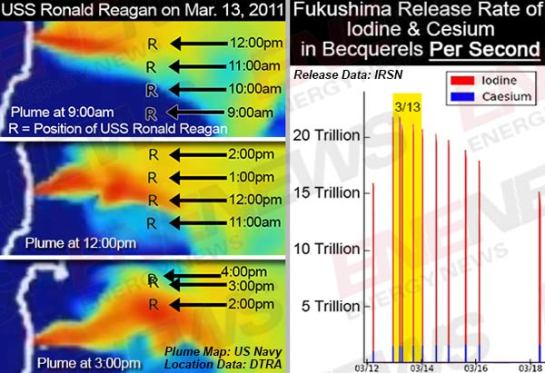” Dear Prime Minister Shinzo Abe,
Let me first acknowledge that after four long years of silence, the Japanese government has finally taken a position regarding the lawsuit filed against Tokyo Electric Power Co. in the U.S. by more than 450 American sailors, marines and civilians who were on board the USS Reagan and accompanying military ships off the coast of Tohoku after 3/11.
These young people experienced serious health problems resulting from, they allege, radiation exposure while participating in Operation Tomodachi, the U.S. military’s humanitarian rescue mission launched in response to the Great East Japan Earthquake and tsunami of March 11, 2011, and subsequent multiple meltdowns at the Fukushima No. 1 nuclear plant.
While the Japanese government’s acknowledgement of the suit is welcome, the unconditional support it has given to Tepco is a matter of deep concern. Even now, U.S. service personnel find themselves prevented from seeking justice because Tepco, with the support of the Japanese government, is doing its utmost to ensure the case will never be heard in an American court.
The Japanese government submitted an amicus curiae brief to the Ninth Circuit Court of Appeals on Feb. 3. An amicus curiae (friend of the court) brief is one presented by a party not directly involved in the suit in the hope of influencing the outcome. The brief contains two points:
1. “The Government of Japan has developed a comprehensive system to ensure compensation for victims of the Fukushima Nuclear Accident.”
2. “Damage claims brought in tribunals outside of Japan threaten the continuing viability of the compensation system established by the Government of Japan.”
Examining the first point, if the Japanese government truly had “a comprehensive system to ensure compensation for victims,” there would be no need for the U.S. service members’ lawsuit. Yet, as you know, the Japanese government and its subsidiaries have, to date, not paid a single yen to any non-Tepco-related victim of radiation exposure from Fukushima No. 1. This includes, as of March this year, a total of 173 children from the prefecture who underwent surgery after being diagnosed with suspected thyroid cancer, 131 of whom were confirmed to have had cancer.
If the Japanese government will not admit that the suffering of its own children was caused by radiation exposure, how confident can young Americans be that the apparently radiation-induced injuries they experienced will be recognized as such, let alone compensated for, in Japan?
Further, at least seven of these previously healthy young Americans have already died and many others are too ill to travel to Japan even if they could afford to, let alone reside in this country during lengthy legal procedures, which typically take years to resolve. This is not to mention the prospect of expensive legal costs, including for court fees, hiring Japanese lawyers, translation of relevant documents, etc. And let us never forget, Prime Minister, it was the Japanese government that requested the assistance of these American military personnel.
As for the second point above, I agree the U.S. military personnel’s lawsuit threatens “the continuing viability of the compensation system established by the Government of Japan.” For example, if a U.S. court were to ascribe the plaintiffs’ illnesses to radiation exposure, how could the Japanese government continue to claim that none of the many illnesses the children and adults of Fukushima presently experience are radiation-related? The American service personnel truly serve as “the canary in the coal mine” when it comes to demonstrating the damaging effects of radiation exposure. Moreover, this canary is out of the Japanese government’s ability to control.
Let us further suppose that an American court were to award $3 million per person as compensation for the deaths, currently standing at seven, of the military personnel who were irradiated. By contrast, the Japanese government continues to deny compensation, for radiation-induced illnesses let alone deaths, to its own citizens. This would surely impact the “viability” (not to mention reputation) of the Japanese government in its ongoing denial of radiation-related injuries to non-Tepco employees.
Let me close by noting that there is one Japanese political leader who has accepted personal responsibility for the injuries inflicted on American service personnel. I refer to former Prime Minister Junichiro Koizumi who, after meeting with injured servicemen and women in San Diego in May, initiated a fund to meet as many of the medical needs of these sailors and marines as possible.
Fortunately, thanks to the support of thousands of ordinary Japanese, he has already raised $700,000 toward his $1 million goal. With tears in his eyes, Koizumi explained that he could not ignore the suffering of hundreds of formerly healthy young Americans who willingly put themselves at risk in order to render aid to the Japanese people.
Prime Minister Abe, I call on you to end the Japanese government’s unconditional legal support of Tepco. Further, if the Japanese government has a conscience, please immediately provide medical aid and compensation to the hundreds of American victims of Operation Tomodachi. ”
by Brian Victoria
